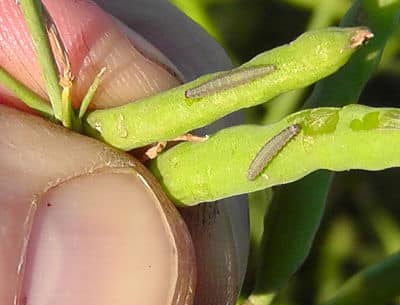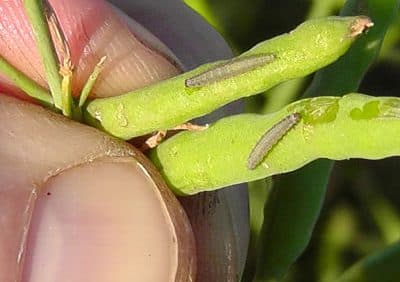
Thresholds for diamondback moth larvae are 100-150 larvae per square metre in immature to flowering plants and 200-300 larvae per square metre (20-30 per square foot) in plants with flowers and pods.
While these nominal thresholds are based on dense stands of 150-200 plants per square metre, plant population is not a major factor. Fewer plants will have more branching and more pods, so the number of pods per square foot probably won’t change much regardless of plant population.
When counting diamondback moth larvae, pull out all plants within one square foot, bang them on the hood of your nearby truck or on a dropcloth or large piece of cardboard, and count the larvae. Sample a few areas of the field. Note that looking at only individual plants will not give an accurate impression of risk, especially if the plants selected are only those that have obvious signs of larvae damage. Thresholds require a more random approach, which is what you get by sampling all plants within a square foot and checking a few different sites.
If counts are near or above thresholds, look for damage before deciding to spray. Pod feeding is the only feeding likely to cause economic damage.
A patient approach can pay off. Diamondback moth larvae are small and cannot do the rapid damage that bertha armyworms can do. If diamondback moth larvae are at thresholds, waiting a couple of days can bring a dramatic change in numbers. In two days…
—Rain could wash larvae to the ground where beetles and other beneficials can eat them.
—Parasitic wasps could take over the population. Natural enemies are hard at work on diamondback moth larvae and they often take care of a threat before the pest reaches a yield-robbing level. One specific parasitic wasp, Diadegma insulare, is more successful at moderate temperatures (22°C) than under hotter weather (30°C), so cool wet weather could improve their control of the diamondback moth.
—Many of the worms could pupate. Diamondback moths have relatively short life cycles.
However, if you come back in two days and numbers are up and pod feeding has increased, this is a case where spraying is probably warranted.
Ignore diamondback moths that show up in the sweep net. Sweep nets cover a wide area in a short time, so even if you find a few dozen in 10 sweeps, they may not be at thresholds.
In one example, a grower found 80 diamondback moth larvae in 10 sweeps. This sounds alarming, but when the grower did the proper foot-square counts, he discovered that numbers were slightly below the threshold. He opted not to spray.
Further reading:
Combining thresholds when more than one insect is present but below thresholds on their own.

